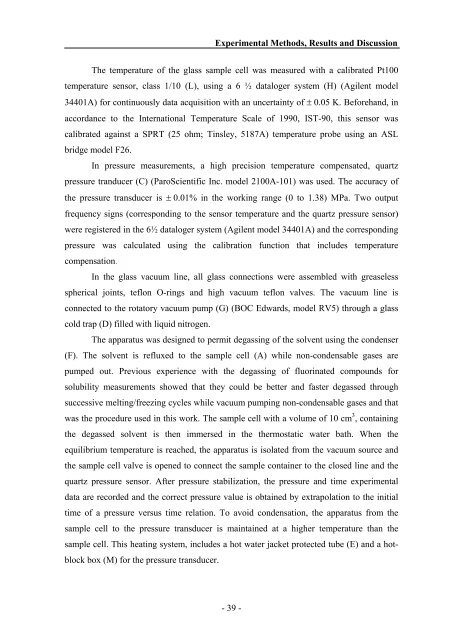n - PATh :.: Process and Product Applied Thermodynamics research ...
n - PATh :.: Process and Product Applied Thermodynamics research ...
n - PATh :.: Process and Product Applied Thermodynamics research ...
Create successful ePaper yourself
Turn your PDF publications into a flip-book with our unique Google optimized e-Paper software.
Experimental Methods, Results <strong>and</strong> Discussion<br />
The temperature of the glass sample cell was measured with a calibrated Pt100<br />
temperature sensor, class 1/10 (L), using a 6 ½ dataloger system (H) (Agilent model<br />
34401A) for continuously data acquisition with an uncertainty of ± 0.05 K. Beforeh<strong>and</strong>, in<br />
accordance to the International Temperature Scale of 1990, IST-90, this sensor was<br />
calibrated against a SPRT (25 ohm; Tinsley, 5187A) temperature probe using an ASL<br />
bridge model F26.<br />
In pressure measurements, a high precision temperature compensated, quartz<br />
pressure tr<strong>and</strong>ucer (C) (ParoScientific Inc. model 2100A-101) was used. The accuracy of<br />
the pressure transducer is ± 0.01% in the working range (0 to 1.38) MPa. Two output<br />
frequency signs (corresponding to the sensor temperature <strong>and</strong> the quartz pressure sensor)<br />
were registered in the 6½ dataloger system (Agilent model 34401A) <strong>and</strong> the corresponding<br />
pressure was calculated using the calibration function that includes temperature<br />
compensation.<br />
In the glass vacuum line, all glass connections were assembled with greaseless<br />
spherical joints, teflon O-rings <strong>and</strong> high vacuum teflon valves. The vacuum line is<br />
connected to the rotatory vacuum pump (G) (BOC Edwards, model RV5) through a glass<br />
cold trap (D) filled with liquid nitrogen.<br />
The apparatus was designed to permit degassing of the solvent using the condenser<br />
(F). The solvent is refluxed to the sample cell (A) while non-condensable gases are<br />
pumped out. Previous experience with the degassing of fluorinated compounds for<br />
solubility measurements showed that they could be better <strong>and</strong> faster degassed through<br />
successive melting/freezing cycles while vacuum pumping non-condensable gases <strong>and</strong> that<br />
was the procedure used in this work. The sample cell with a volume of 10 cm 3 , containing<br />
the degassed solvent is then immersed in the thermostatic water bath. When the<br />
equilibrium temperature is reached, the apparatus is isolated from the vacuum source <strong>and</strong><br />
the sample cell valve is opened to connect the sample container to the closed line <strong>and</strong> the<br />
quartz pressure sensor. After pressure stabilization, the pressure <strong>and</strong> time experimental<br />
data are recorded <strong>and</strong> the correct pressure value is obtained by extrapolation to the initial<br />
time of a pressure versus time relation. To avoid condensation, the apparatus from the<br />
sample cell to the pressure transducer is maintained at a higher temperature than the<br />
sample cell. This heating system, includes a hot water jacket protected tube (E) <strong>and</strong> a hotblock<br />
box (M) for the pressure transducer.<br />
- 39 -



